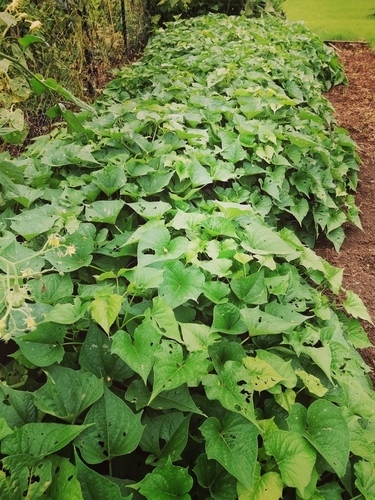Benefits of Edible Kumara (Sweet Potato) Leaves
Did you know that Kumara leaves (as they are known in NZ) are edible and they are actually very good for us?!
Often we only focus on the root and the rest is thrown away, even if it does go back into the compost. But ALL of the kumara plant is edible, although the most nutritious are the leaves.
Treat kumara leaves as you would spinach in your meals!
- Raw: just like any dark leafy green you can add them to your salads
- Sauteed: roughly chop them up and sauté them with some butter and garlic
- Boiled: boiling sweet potato vine leaves will help remove their bitterness.
- Juiced: add them into your daily juice for a vitamin kick.
Kumara leaf vitamins and minerals:
- Vitamins: A, C, K, B1, B2, B3, B9
- Vitamin K (which kumara vines are high in) helps reduce the risk of osteoporosis and hip fractures
- Minerals: calcium, iron, magnesium, phosphorus, potassium
- Also contains zinc, manganese, copper
By the way, just ONE sweet potato gives you 400% of the vitamin A you need each day!
Kumara are also:
- High in antioxidants, which can help prevent or delay damage to cells in the body
- Kumara leaves are full of fibre which helps regulate your bowel movements and gastrointestinal tract
- Consumption of the leaves can also help prevent some chronic diseases like inflammation, heart disease, hypertension, diabetes and some cancers
Medicinally: Kumara leaves and vine are a common Rongoa used for wharetangata (wombs), toning uterus in preparation for baby and prostate. It was also used to prevent jaundice in pepi (baby).
They were traditionally said to boost metabolism, support digestive processes, anaemia, and help with a low mood.
A cooked kumara is used to draw and heal any infected wounds also.
Cooking tips:
- For the most nutrients, choose healthy sweet potatoes with deep green leaves and dark flesh
- The whole tips of the sweet potato are edible, including the leaves, stems, and leaf stalks. The leaves, however, are the most nutritious
- Use sweet potato leaves immediately for the best use and most nutrients. Otherwise, store the leaves properly (refrigeration or cool, dark place with stems in water)
- Fat is important for the absorption of vitamin A, so cook the leaves with some fat (e.g. small amounts of oil or butter) to help the body absorb vitamin A. The amount of fat required can vary (2.4 to 5 g/meal) for cooked vegetables. If you consume the leaves raw as a salad, eat them with a dressing that has some fat (e.g. oil)
- Don’t cook the leaves for too long or some nutrients may be lost.
Posted: Friday 11 February 2022
Comments
-
★★★★★I eat kumara leaves. They grow so easily and are free nutrition. They are soft and have an unusual but mild taste. Great value! I occasionally dig up some kumara but I'm not a great gardener.Posted: 2024-05-10 11:12 by Suzie
-
★★★The stalks make up a lot of the plant, and are very stringy and are a choking hazard.
It's a shame because the plant is tasty.
The leaves I tried were commercially produced and young and tender (brought from a Chinese supermarket), but inspite of young and fresh leaves, still got stuck in the throat.Posted: 2023-11-23 09:30 by SadButTrue -
★★★★★I live in a retirement village and only have a small east facing balcony. Two organic kumara, planted around January have kept me eating greens every day thru autumn and there is sure more than enough to share thru winter. There will be some yummy kumara growing in the soil, but I wont be digging them up, because I love the leaves. Do you know their oxalate level? As high as spinach?Posted: 2023-05-29 09:19 by MarniResponse From The OwnerThat's wonderful to hear, well done! There is far less oxalates in kumara leaves than spinach. Spinach contains hundreds of milligrams of oxalates per 1/2 cup, kumara average about 30-40 milligrams of oxalates per half cup.

